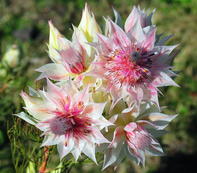Indigenous cut-flowers from South Africa include a range of farmed and wild-harvested flowers and greenery - foliage. Retail buyers often use the generic term ‘fynbos’ to refer to the selection of flowers that include proteas, ‘pincushions’, cones and foliage.

A more official term describing South African indigenous cut-flowers is ‘Cape Flora’. Not only ‘stems’ and bouquets of flowers are exported from South Africa; there are also dried cut-flowers as well as indigenous plant material for replanting. Leucospermums, with their ease of rooting and striking floral display, make good potted plants.
In this article, we will focus on Cape Flora - fresh indigenous cut-flowers and foliage.
Types of South African Cut-flowers

According to Cape Flora SA, the main commercially grown indigenous cut-flowers are members of the Proteaceae family. This includes the proteas, but also the Leucadendron and Leucospermum.
Serruria florida (‘Blushing Bride’), Brunia (also called ‘knoppies’ of ‘volstruisies’ in Afrikaans), Chamelaucium (waxflowers) and others such as Phylica (e.g. featherhead) and Erica species are also grown. Erica (also known as heather or ‘heide’ in Afrikaans) is a genus of over 860 species, with tiny needle-like leaves and small flowers worn on spikes. It is typical of the fynbos of the Cape Floral Kingdom in the Western Cape Province.
The woody and evergreen Leucospermums, can grow in varieties from small trees to sprawling ground covers, and produce open flowers with needle-like flowerheads, resembling a pincushion. Common names for these proteas are ‘pincushion’ or ‘speldekussing and ‘bobbejaanklou’ in Afrikaans. Flowers are available in white, yellow, pink, orange or red and make a long-lasting and popular cut-flower. The production season for Leucospermums is late winter to late spring.
The South African genus Leucadendron contains about 60 species, generically termed ‘conebushes’. Many of the Leucadendron species are grown for their decorative and colourful foliage. Leucadendron argenteum, or ‘silver tree’ is an example. This plant with its distinctive leaves with glistening silvery hairs, is usually found as a tree and makes a popular landscape plant. The leaves are used as long-lasting foliage.
Apart from the colourful foliage and decorative cones, the Leucadendron species are also popular for their long stems, ease of packing and high yields. Under intensive management in Israel, the Leucadendron ‘Safari Sunset’, produces yields of more than 600 000 marketable stems per hectare per year. Leucadendrons are available during the Southern Hemisphere winter and spring.
Almost half of the 36 million stems of Cape Flora exported during 2016/2017 were greens and grasses. Species sold under the term ‘greens’ include Eucalyptus (top-seller), Brunia, Geraldton wax, Erica and Berzelia species (‘kolkol’ in Afrikaans). ‘Grasses’ include top-seller Typha (cattail reed), but also restios, bell reed and the newcomer rekoala.
By Marinda Louw
For bulk or Cut-flowers export enquiries please use the enquiry link below.